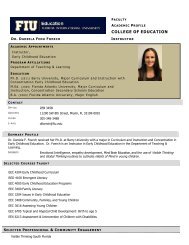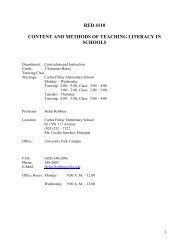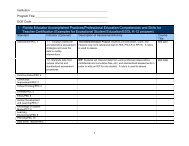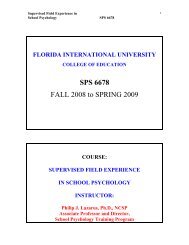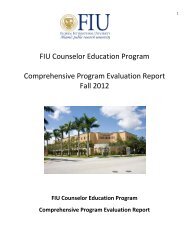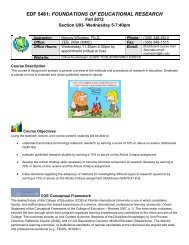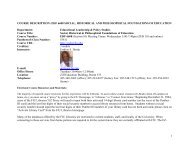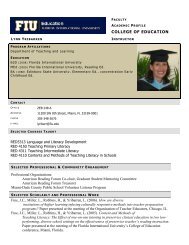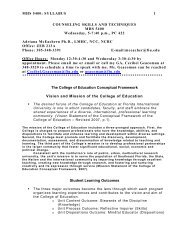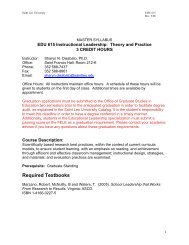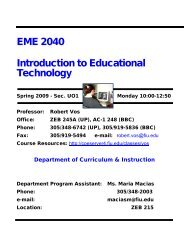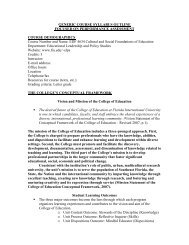2007 - College of Education - Florida International University
2007 - College of Education - Florida International University
2007 - College of Education - Florida International University
Create successful ePaper yourself
Turn your PDF publications into a flip-book with our unique Google optimized e-Paper software.
navigation. We analyzed the data to identify the response percentages for the indicated sample.<br />
We sought to describe the influence three promotional efforts had on athletic training students<br />
while in high school by observing the influence <strong>of</strong> internships, mentorship experience and SSP.<br />
We attempted to answer the following research question: (a) What influences allied<br />
health majors in their career path To answer this research question, we identified three<br />
components <strong>of</strong> particular interest: (b) Are internships influential in a student’s decision on a<br />
career path (c) Are mentors influential in a student’s decision on a career path (d) Are SSPs<br />
influential in a student’s decision on a career path<br />
Participants<br />
We used randomized criterion sampling to solicit potential participants. We identified<br />
accredited athletic training education programs via the National Athletic Training Association<br />
website (www.nata.org). We compiled a list <strong>of</strong> accredited programs from the eastern United<br />
States, defined as states east <strong>of</strong> the Mississippi River. States included in the study had at least<br />
five accredited programs. We randomly selected ten states by pulling their names out <strong>of</strong> a box.<br />
We included all programs from the selected states in the study. Our target sample size was 200<br />
participants. We excluded minors, college freshmen and undecided majors because <strong>of</strong> their<br />
potential to select a program other than athletic training.<br />
Instruments<br />
We modified a questionnaire used to evaluate student recruitment in allied health<br />
education programs. 1 The questionnaire was distributed and collected data with an electronic<br />
questionnaire via a secure website (www.surveymonkey.com). The survey entitled “Influences<br />
on Career Selection Survey” (ICSS) included 32 Likert-type questions. We divided the ICSS<br />
into 6 sections: (1) Demographics, (2) General influences on career choice, (3) Influence <strong>of</strong><br />
internships, (4) Influence <strong>of</strong> mentorship, (5) Influence <strong>of</strong> school programs, and (6) Influences in<br />
a comprehensive high school. The s<strong>of</strong>tware permitted only one answer per question, as needed.<br />
The s<strong>of</strong>tware automatically skipped questions based on previous responses, progressing<br />
respondents to the next applicable question. To increase compliance and assure confidentiality,<br />
all respondents were anonymous.<br />
Procedures<br />
We solicited participation by contacting undergraduate program directors via email. Each<br />
program director received an IRB approved email cover letter that included a hyperlink to the<br />
survey which they forwarded to their students. Informed consent was implied if students<br />
proceeded to the survey. To further improve response rates, we sent a follow-up email to<br />
program directors 2 weeks later. The survey took respondents 10-15 minutes to complete.<br />
Pilot Testing. We established content and construct validity and internal consistency <strong>of</strong><br />
the instrument through pilot testing. We distributed the questionnaire to a panel <strong>of</strong> faculty and<br />
pr<strong>of</strong>essional peers to evaluate ease <strong>of</strong> website navigation and to thoroughly analyze each<br />
question. The panel also ensured that each survey question pertained to the research question.<br />
Following revisions, we redistributed the instrument to faculty and peers for final analysis.<br />
Statistical Analysis<br />
We assigned numeric codes to responses and used statistics to describe central tendency,<br />
(frequency, mode, mean) to analyze the data.<br />
Results<br />
From the universities meeting the inclusionary criteria, 230 participants completed the<br />
online questionnaire. We eliminated 13 participants because they did not meet the inclusionary



